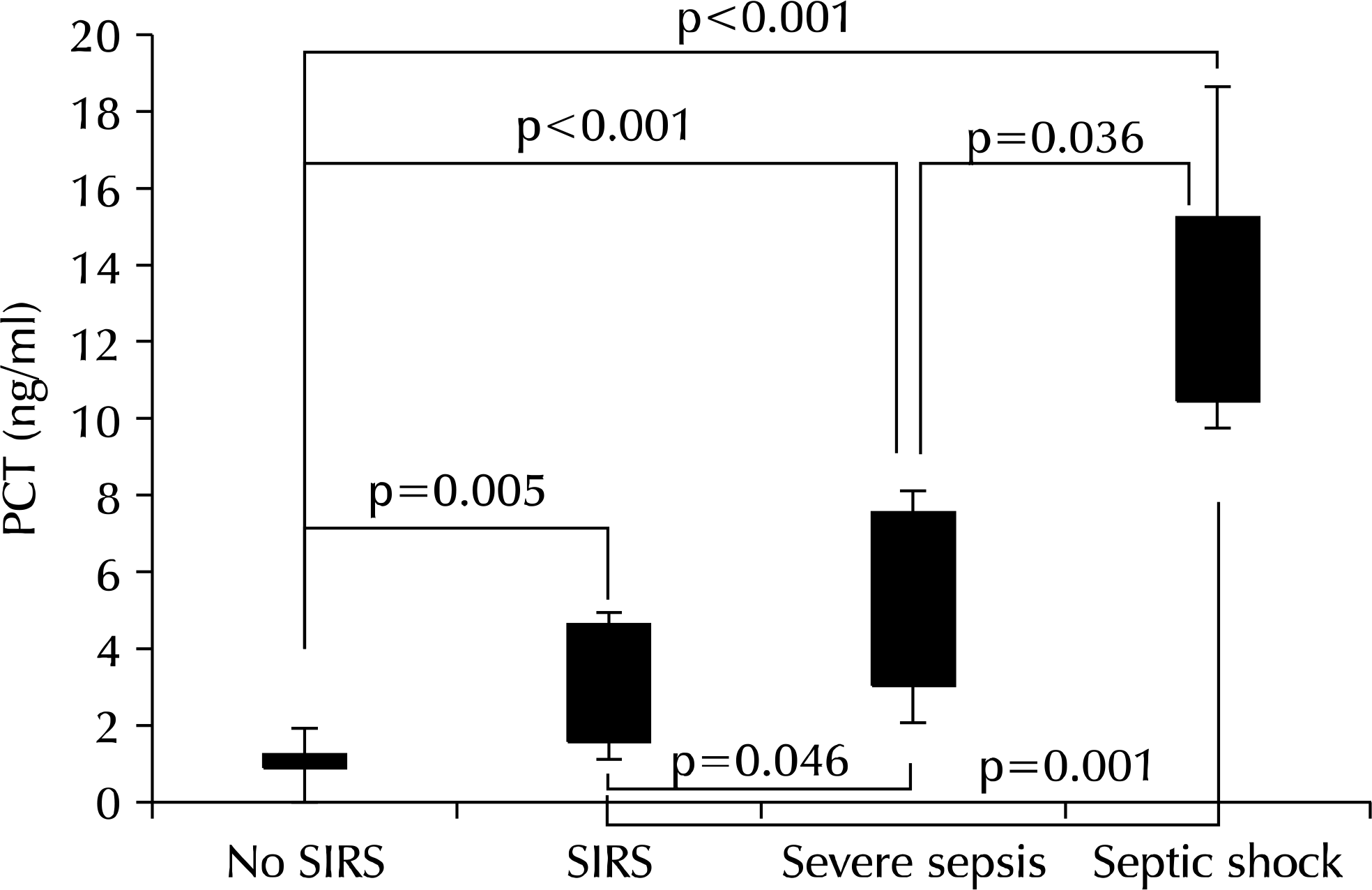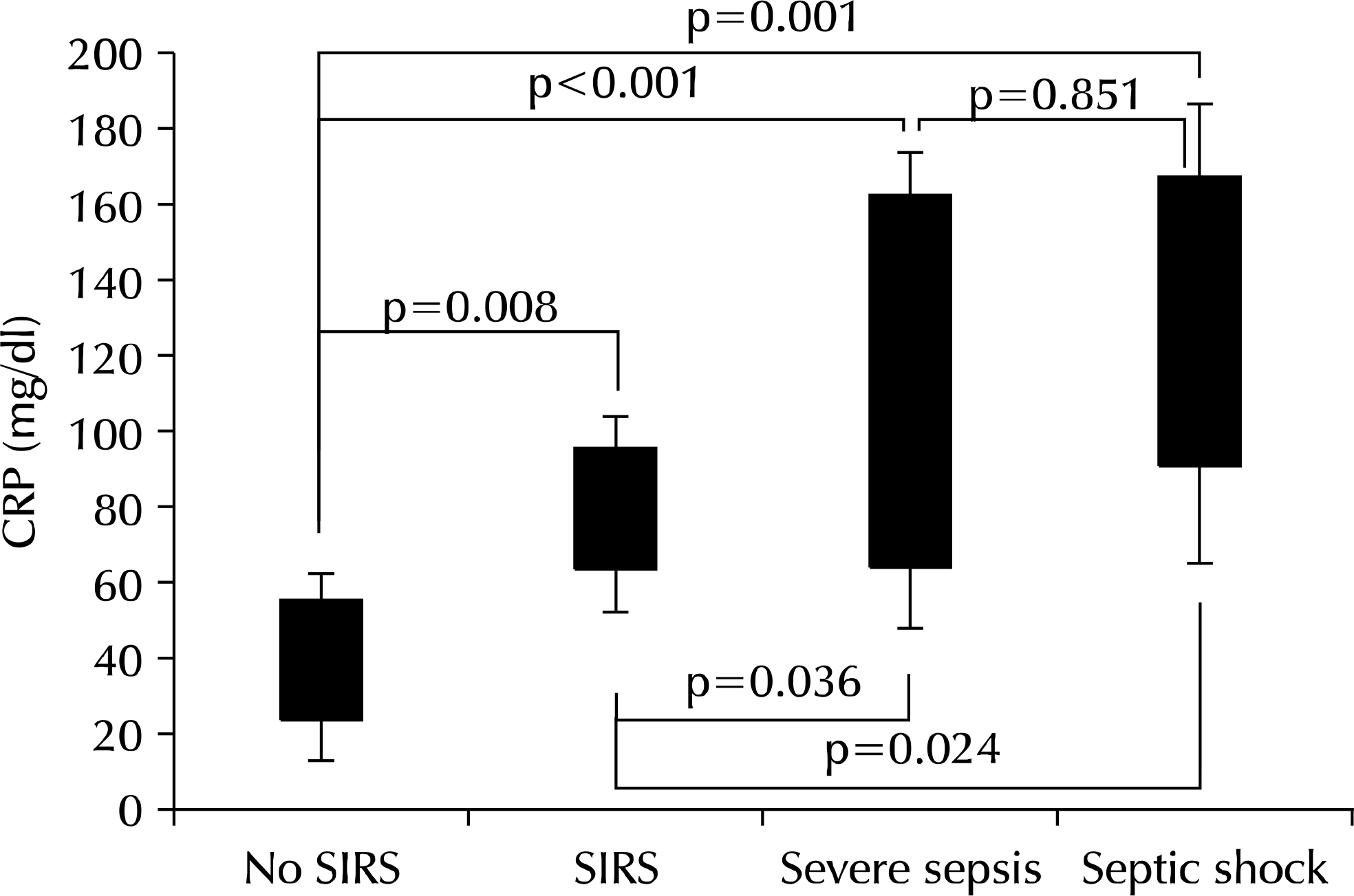Abstract
Purpose:
Acute pyelonephritis (APN) is accompanied by bacteremia and has a high incidence of mortality. Currently, there is a limited number of rapid diagnostic tests that can predict the severity of infection and suitable treatments for patients with APN. Herein, we determined whether serum procalcitonin (PCT) is a useful predictive and early cognitive marker according to the severity of APN.
Materials and Methods:
Patients were divided into four groups according to the severity of infection: (1) No systemic inflammatory response syndrome (SIRS), (2) SIRS, (3) severe sepsis, and (4) septic shock. We measured the inflammatory biomarkers—PCT, C-reactive protein (CRP), and erythrocyte sedimentation rate. One way ANOVA analysis was performed between the measured infection markers and the severity of infection. The p-value of less than 0.05 was considered by the post-hoc multiple comparisons.
Results:
A total of 381 patients with APN were divided into four groups: (1) no SIRS (n=126, 33.1%), (2) SIRS (n=185, 48.6%), (3) severe sepsis (n=47, 12.3%), and (4) septic shock (n=23, 6.0%). PCT (p<0.001) and CRP (p=0.002) showed a significant difference among the group. Greater severity of infection grade was associated with higher PCT and CRP values. According to the multivariate analysis, there was a statistically significant difference of PCT among all grades.
REFERENCES
1.Bone RC., Balk RA., Cerra FB., Dellinger RP., Fein AM., Knaus WA, et al. Definitions for sepsis and organ failure and guidelines for the use of innovative therapies in sepsis. The ACCP/SCCM Consensus Conference Committee. American College of Chest Physicians/Society of Critical Care Medicine. Chest. 1992. 101:1644–55.
2.Dandona P., Nix D., Wilson MF., Aljada A., Love J., Assicot M, et al. Procalcitonin increase after endotoxin injection in normal subjects. J Clin Endocrinol Metab. 1994. 79:1605–8.

3.Gendrel D., Raymond J., Coste J., Moulin F., Lorrot M., Guerin S, et al. Comparison of procalcitonin with C-reactive protein, interleukin 6 and interferon-alpha for differentiation of bacterial vs. viral infections. Pediatr Infect Dis J. 1999. 18:875–81.

4.Groselj-Grenc M., Ihan A., Pavcnik-Arnol M., Kopitar AN., Gmeiner-Stopar T., Derganc M. Neutrophil and monocyte CD64 indexes, lipopolysaccharide-binding protein, procalcitonin and C-reactive protein in sepsis of critically ill neonates and children. Intensive Care Med. 2009. 35:1950–8.

5.Selberg O., Hecker H., Martin M., Klos A., Bautsch W., Kohl J. Discrimination of sepsis and systemic inflammatory response syndrome by determination of circulating plasma concentrations of procalcitonin, protein complement 3a, and interleukin-6. Crit Care Med. 2000. 28:2793–8.

6.Korppi M., Heiskanen-Kosma T., Leinonen M. White blood cells, C-reactive protein and erythrocyte sedimentation rate in pneumococcal pneumonia in children. Eur Respir J. 1997. 10:1125–9.

7.Melbye H., Straume B., Brox J. Laboratory tests for pneumonia in general practice: the diagnostic values depend on the duration of illness. Scand J Prim Health Care. 1992. 10:234–40.

8.Benador N., Siegrist CA., Gendrel D., Greder C., Benador D., Assicot M, et al. Procalcitonin is a marker of severity of renal lesions in pyelonephritis. Pediatrics. 1998. 102:1422–5.

9.Tuerlinckx D., Vander Borght T., Glupczynski Y., Galanti L., Roelants V., Krug B, et al. Is procalcitonin a good marker of renal lesion in febrile urinary tract infection? Eur J Pediatr. 2005. 164:651–2.

10.Brunkhorst FM., Heinz U., Forycki ZF. Kinetics of procalcitonin in iatrogenic sepsis. Intensive Care Med. 1998. 24:888–9.

11.Ugarte H., Silva E., Mercan D., De Mendonça A., Vincent JL. Procalcitonin used as a marker of infection in the intensive care unit. Crit Care Med. 1999. 27:498–504.

12.Viallon A., Zeni F., Lambert C., Pozzetto B., Tardy B., Venet C, et al. High sensitivity and specificity of serum procalcitonin levels in adults with bacterial meningitis. Clin Infect Dis. 1999. 28:1313–6.

13.Schuetz P., Christ-Crain M., Thomann R., Falconnier C., Wolbers M., Widmer I, et al. Effect of procalcitonin-based guidelines vs standard guidelines on antibiotic use in lower respiratory tract infections: the ProHOSP randomized controlled trial. JAMA. 2009. 302:1059–66.
Fig. 1.
Procalcitonin (PCT) increased depending on the infection severity (p<0.001). PCT did show all significant differences among four subgroups. SIRS: systemic inflammatory response syndrome.

Fig. 2.
C-reactive protein (CRP) increased depending on the infection severity (p=0.002). However, there was no difference in CRP between severe sepsis and septic shock (p=0.851). SIRS: systemic inflammatory response syndrome.

Table 1.
Assessment of the severity grade of sepsis by related parameters (n=381)
| Parameter | No SIRS | SIRS | Severe sepsis | Septic shock | p-value |
|---|---|---|---|---|---|
| No. of patients | 126 (33.1) | 185 (48.6) | 47 (12.3) | 23 (6.0) | |
| Age (y) | 46.11±14.27 | 45.76±15.86 | 53.43±12.42 | 63.23±16.32 | 0.854 |
| Temperature (oC) | 38.06±1.86 | 38.08±0.85 | 38.08±0.91 | 38.13±0.83 | 0.605 |
| WBC (×103/mm3) | 8.7±3.4 | 11.8±3.9 | 9.3±4.3 | 8.1±4.1 | 0.681 |
| PLT (×103/mm3) | 225.3±89.7 | 211.3±97.2 | 216.4±102.2 | 199.2±103.7 | 0.136 |
| PCT (ng/ml) | 0.12±0.04 | 1.30±0.42 | 7.10±2.11 | 15.23±4.43 | <0.001a) |
| CRP (mg/dl) | 38.72±21.86 | 88.03±15.86 | 96.18±37.43 | 132.76±45.68 | 0.002a) |
| ESR (mm/h) | 45.76±25.11 | 54.23±15.86 | 57.45±36.18 | 58.05±20.24 | 0.816 |




 PDF
PDF ePub
ePub Citation
Citation Print
Print


 XML Download
XML Download